A Reproduction Red Wool Broadcloth Cloak
with details taken from two extant examples
One of our friends recently joined our Rev War unit and is looking to update to her wardrobe to reflect our CT-based interpretation. She was in need of a cloak to help weather the sometimes below-freezing CT winter temperatures and knew she wanted a red one copied directly from the one featured in Costume Close-up, since that was one of the pieces that made her first start to fall in love with 18th century fashion. So we added a couple of extra details copied from a similar extant cloak with a CT provenance and this is the end result! I'm in love and want one for myself now! :-) So here are all the nitty-gritty details:
The pattern: The pattern for this cloak is taken directly from an extant original in the collections of Colonial Williamsburg (CW acc. no. 1953-968), patterned to scale in Linda Baumgarten's indispensable Costume Close-up, pgs. 54-56. Every detail of the construction, right down to the piecing on the hood and the body, has been reproduced, with the exception of the slits for the arms, which we left out simply because our friend didn't think she'd use them, which would render them rather counter-productive by letting the cold air in!
The cloak's source pattern and primary inspiration, a red wool broadcloth example
from the collections of Colonial Williamsburg (CW acc. no. 1953-968).
Photo from the CW Online Collections database.
Inspirations: The hood lining and front facing details were inspired by the Williamsburg cloak. Costume Close-up indicates that "originally, the hood was lined with with soft thin silk and the cloak front was faced with taffeta; there was not a full lining." What isn't specified, however, is the color of the original hood lining and front facings, so I turned for further inspiration to another cloak source which I had the opportunity to examine in person last year, this one with the requisite CT provenance! Similar in cut and construction to the CW example, this second inspiration cloak owned by the CT Historical Society features the same hood lining and front facing details that Baumgarten cites - and in a very striking black!
The second inspiration cloak, this one from the
CT Historical Society (CHS acc. no. 1972.3.1).
Photo from the CHS eMuseum listing.
The hood of the CHS cloak is half-lined in a thin black silk. The front opening edges of the cloak's body are bound and faced with strips of black silk which are sewn on in such a way that only a narrow band of black is visible from the outside, and a much wider band of 2 5/8" on the inside. These details were translated onto my reproduction.
Construction details: The cloak is entirely hand-sewn in a golden-brown silk thread, which reproduces the thread choice on the extant CW piece.
What I find so fun and exciting about cloaks - which otherwise might appear pretty boring to make! - is how ingenious they are when it comes to piecing in order to make the most out of the least amount of fabric. Baumgarten estimates that the CW cloak was cut from 2 3/4 yds of 55", which is pretty spot-on; mine ended up taking almost exactly that same length out of 58" width broadcloth.
The cloak's body was cut to make use of the full width of the original 55" fabric. Because my fabric was a touch wider, I of course had to trim off the leftover width on both sides to maintain the measurements and proportions of the original. To complete the full half-circle sweep, the sides are then pieced onto the central body in long, backstitched seams.
The piecing of the cloak's wide body falls at about half-way down the center front.
The cloak's body piecing helps it achieve a generously full half-circle sweep.
Once the body seams were sewn, I then applied the black silk taffeta bindings/facings to the front edges. These serve to encase the front edges to protect them from wear and also add a bit of interest to the front of the cloak with the sharp, eye-catching contrast of color. Only about 3/8" of black is exposed on the outside, with 2 5/8" strips visible on the inside. The remainder of the cloak's edges (including the hood) are left unfinished, as per both original sources. The broadcloth is well-fulled, more than sufficient for maintaining the smooth cut edges.
The cloak half-closed (on the top) and half open (on the bottom)to show the
contrasting widths of the black silk taffeta strips that form the center-front bindings/facings.
The hood is assembled from six different pieces which were all backstitched together with narrow seam allowances to eek out as much fabric as possible. Each of the pieces was cut with the grainline going in a different direction, a feature I was also careful to reproduce as I cut them out. I wish I'd taken a picture of the hood pieces all laid out together before I stitched them because the piecing is a little tough to see on the finished hood.
Detail of the hood piecing.
The hood is then lined in a very lightweight black silk before its back seam is sewn and arranged into the characteristic "fan" pleating detail that appears on the majority of extant cloaks from this period.
The back of the hood, with the signature "fan" pleating.
Finally, the hood is sewn to the body of the cloak. The gathering of the cloak's wide body is concentrated at the center back to allow the cloak to drape gracefully over the shoulders.
The cloak folded in half to show the concentration of pleats at the back of the cloak,
with the front half of the hood joined smoothly to the body.
The cloak spread flat, shown from the outside/back.
The hood lining is used to cover the neckline seam, black wool tapes are added for ties, and then the cloak is finished!
Interior of the cloak.
The hood view from the back when worn, with the black lining providing a
strikingly eye-catching contrast to the red.
Black wool tape is used for the ties, which help support the weight of the cloak when worn.
The fabric: The red wool is a superfine broadcloth of a heavily fulled weight from Burnley and Trowbridge. It's some of the nicest quality broadcloth I've ever worked with (so yes, of course I had to buy some to make a cloak for myself, too!). The color is absolutely spot-on in terms of a match for the inspiration sources.
The black silk used in the hood lining and the front body facings is of two different weights to accurately reflect those used on the original CW example. The hood is lined in a very light-weight silk persian and the front openings are faced with a mid-weight silk taffeta.
Finishing the look: I guess we'll just have to wait for the cloak's first official airing before we finish this section! Stay tuned! :-)

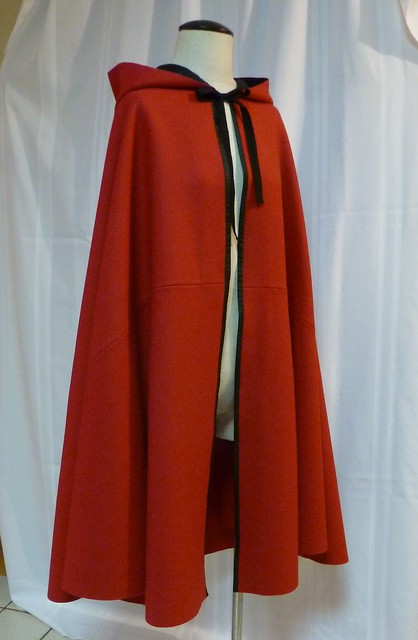


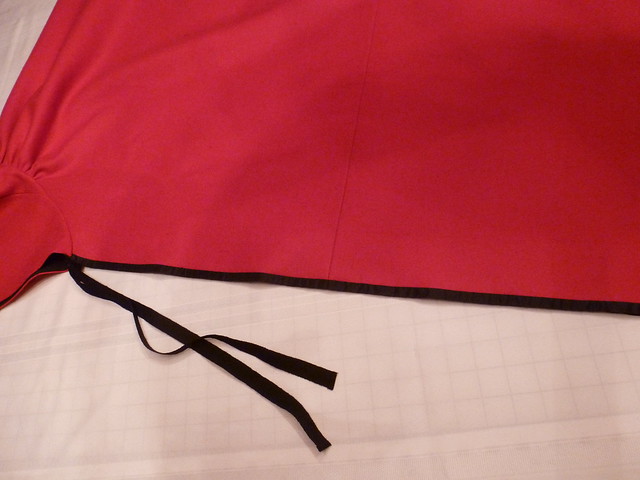
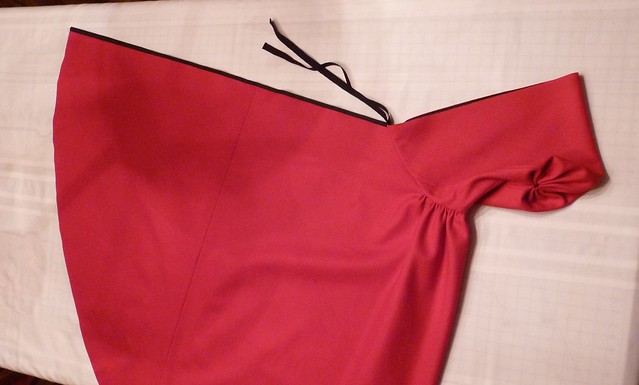

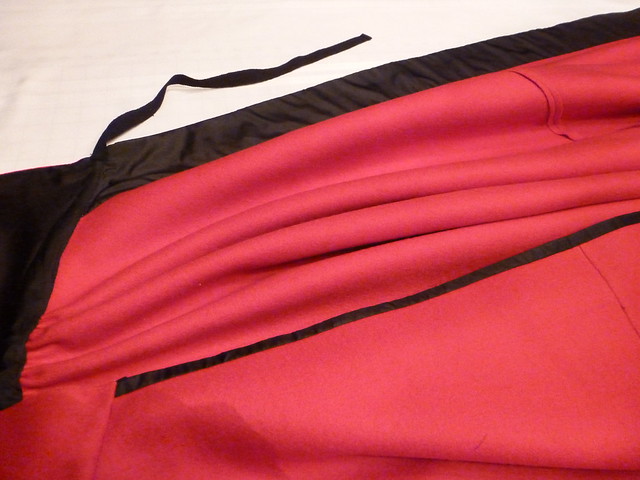
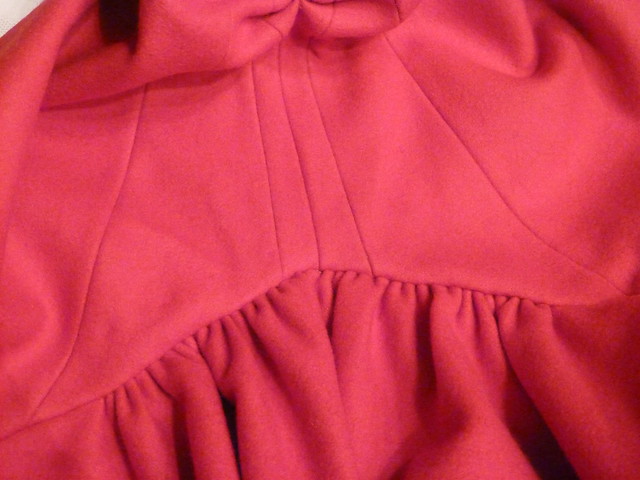
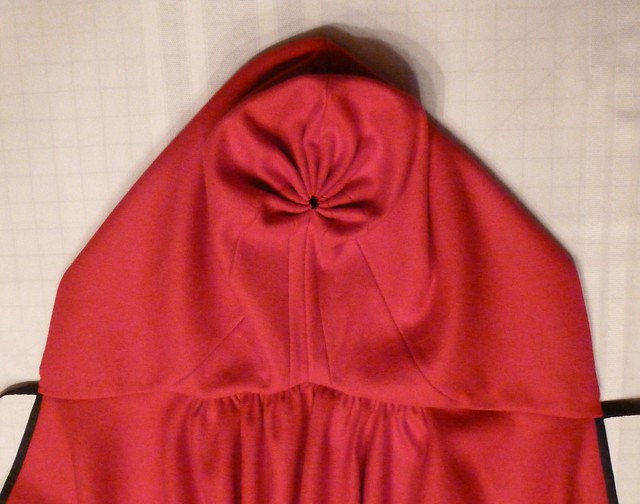
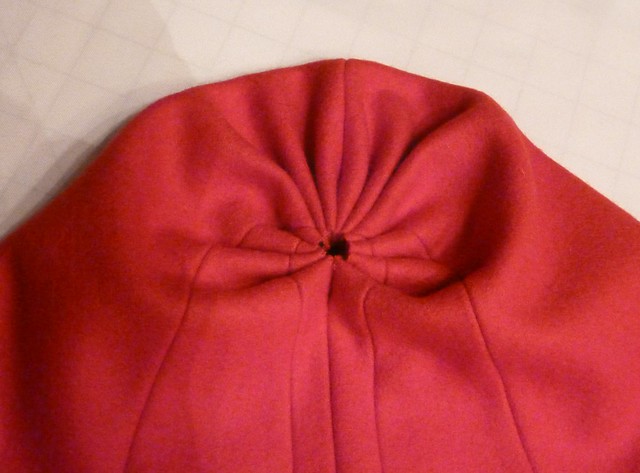



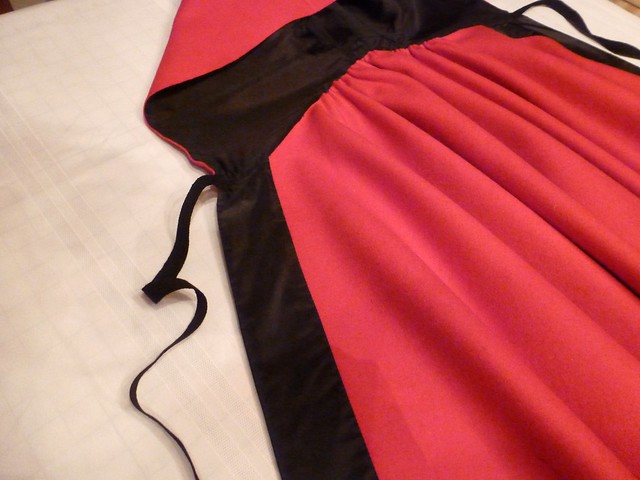
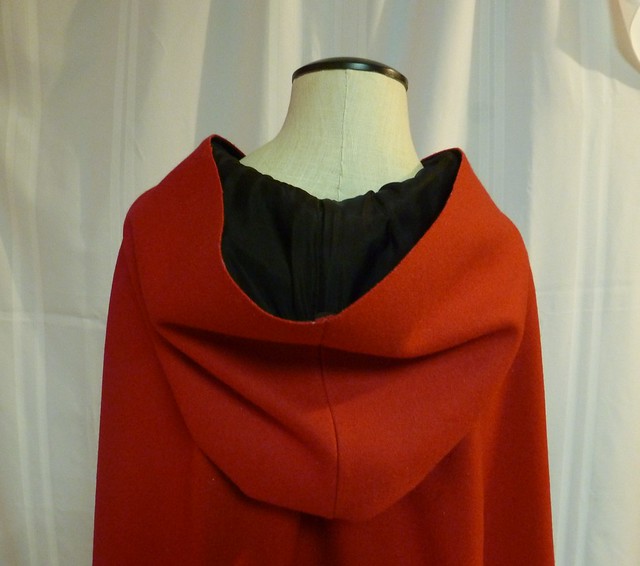
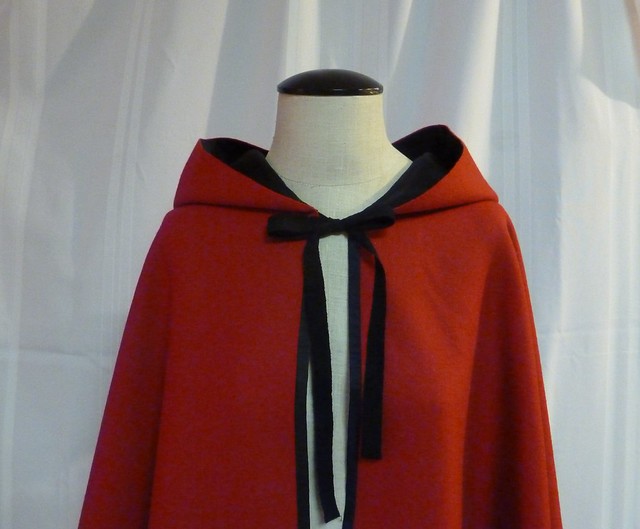
68 comments:
Lovely! I really *do* need a good cloak, but haven't had enough of a need to justify one yet....
Nice to seeing you showing up in my bloglovin' feed again! Keep up the good work on your resolution! ;-)
Do you find the silk makes the hood want to slip off of your head? I have that problem with mine, but perhaps my hood is not shaped properly.
Beautiful cloak!
Hi Hillary!
I don't often use the hood when I wear cloaks, but I have found (when I do!) that a taffeta lining does cause the hood to slip off my head more easily than a silk with a more matte finish, like a silk persian. Experimental archaeology supports extant evidence once again - this explains why cloaks like the CT example use a stronger taffeta for the facing/trim, but opt for a completely different silk in the hood.
This also goes far towards explaining why many (most?) extant cloaks have only half-lined hoods, with either the front (face edge) of the hood lined, or just the bottom edge (along the neckline) lined. This leaves the nap of the wool exposed agains the cap to provide enough friction to keep the hood on the head. The orginal on which my cloak is based has only the bottom half of the hood lined, I would argue for this very reason. :-)
These gowns are really awesome and that red color that which make it fabulous and it is very elegant too. The color you decide makes it very beautiful.Wearing this will give a princess look and it will make us gorgeous.
In my student years, I was very fond of sewing dresses. I have a sewing machine at home. And now I work in writingleader.com and there is absolutely no time. In general, everything is entirely in the work. I need to fix it. Your article inspires a change in life. I'll come home today and try to sew something))
Hello! I'm not really good at sewing but I really like things that have been sewed. This cloak is awesome and looks so cool! I think it's professional work. By the way, if you need help with writing papers you can apply to one writing service that can help you - click here
Red color is my favorite either it is all about flowers or dress. In m point of view , this color is the princes of colors. Essay Writing Service
I think I love your content and the lessons you share with your readers. Every time I read a post, https://masteressaywriters.co.uk/blogs/how-to-reference-in-an-essay-2019-format I feel like I am able to take advantage of this post,
يتم إجراء عملية تكميم المعدة بالمنظار مع شقوق صغيرة، مما يعني أنها تحتوي على ندبات قليلة، وأوقات شفاء سريعة وألم أقل. تساعد عملية تكميم المعدة أيضًا في إنقاص الوزن على المدى الطويل من خلال الحد من كمية الطعام التي يمكن تناولها مرة واحدة وتقليل هرمونات الجوع في الجسم.
شركة نقل الاثاث بالمنصورة
Taking a few minutes and actual effort to generate a top notch article.
Thanks so much for the blog post.
Extremely decent blog and articles.
Presently I am discovered which I really need.
I like it when people get together and share views. Great website.
I’m glad that you just shared this helpful information with us.
Greetings! Very helpful advice within this post!
Also, I’ve shared your website in my social networks.
Thank you, I will try and check back more frequently.
I honestly appreciate individuals like you! Take care!!
I am unable to read articles online very often, but I’m glad I did today.
This is very well written and your points are well-expressed.
Valuable information. Quality content is good.
This blog carries amazing and genuinely data
Thank you for your post, I look for such article along time, today I find it finally.
Very informative and well-written post! Greatjob for your hardwork man!
It’s really a great and useful piece of information. Keep doing it!
I am glad that you shared this useful information with us. Thankyou
Please keep us up to data like this. Thanks for sharing and Keep on writing
Everyone loves it Great website, continue the good work! Thanks
I'll bookmark it and come back to read more of your useful info. Thanks
Some truly superb blog posts on this website , thanks for contribution.
Your style is very unique in comparison to other folks I ave read stuff from.
Many thanks for posting when you have the opportunity.
Excellent information Providing by your Article
,thank you for taking the time to share with us such a nice article.
Here are some links to web pages that we link to simply because we feel they’re really worth visiting.
wow, awesome blog post. Much thanks again.
how you can write in such a creative way.
I’m just working on a topic like that. I hope my blog helps you.
You make so many great points here. Thanks for this fantastic post
Thanks for discuss this, Love learning more on this topic. Extremely helpful!
Its really fun to read this. I enjoyed a lot. Great Article its really informative.
The style is so unique. Thanks for publishing this kind of blog, Keep blogging!
تعتبر كلينر للتنظيف حسب تصنيف عملائها افضل شركة تنظيف شقق بالرياض، فإذا كنت تبحث عن شركة موثوقة ومحترفة لتنظيف منزلك فإن كلينر للتنظيف هي الخيار الأمثل .
شركة تنظيف شقق بالرياض
شركة تنظيف بالدمام تقدم افضل خدمة تنظيف افران بارخص اسعار شركات النظافة بالدمام.
شركة تنظيف افران بالدمام
شركة تسليك مجاري براس تنورة من افضل شركات تسليك المجاري بالمنطقة.
شركة تسليك مجاري براس تنورة
تعد شركة ديدي كلين لتنظيف السجاد بمكة واحدة من أبرز الشركات المتخصصة في تقديم خدمات تنظيف السجاد بطرق احترافية وعالية الجودة حيث تعتمد الشركة على أحدث التقنيات والمعدات المتطورة لضمان إزالة البقع والأوساخ بكفاءة.
شركة تنظيف سجاد بمكة
Nice seeing your blog. You have covered each and everything in detail. Thanks
It’s very informative and you are obviously very knowledgeable content on your site.
It as really a Great and helpful piece of info. I am glad that you shared this
I enjoyed reading the entire post.
Thank you so much for the article. Cool.
I enjoyed this just as much as what you did right here. Thanks a lot, Really Cool.
Cool
تستخدم شركة تنظيف كنب بالطائف تستخدم تقنيات مثل التنظيف بالبخار الذي يعتبر فعالاً في القضاء على البكتيريا والميكروبات دون استخدام مواد كيميائية ضارة مما يضمن بيئة صحية ونظيفة.
شركة تنظيف كنب بالطائف
تعتبر شركات تنظيف الكنب بالدمام من الشركات التي تقدم خدمات تنظيف الكنب والمفروشات المختلفة وتتميز بتقديم خدمات عالية الجودة باستخدام أحدث التقنيات والمعدات المتخصصة. كما توفر هذه الشركات فرق عمل مدربة ومجهزة لتنظيف الكنب بجميع أنواعه وأحجامه.
شركة تنظيف كنب بالدمام
استطعنا في شركة دينا نقل عفش حي العزيزية seed way امتلاك أسرار تنظيم عملية نقل الأثاث بشكل احترافي، بدون فقد ولا خدش في المنقولات، حيث نتبع strategy محترفة في تنظيم الأثاث داخل الشاحنات.
دينا نقل عفش حي العزيزية
بالتوفيق تابع اعمال في معالجة مشكلة أدرار الحمام والروائح الكريهة في المنازل والفلل تتطلب جهدًا جماعيًا من المواطنين والشركات المتخصصة مثل شركة مكافحة الحمام بالرياض، من خلال اتباع استراتيجيات فعّالة وتعاون المجتمع في تقليل الجاذبية للحمام، يمكن تحقيق بيئة منزلية نظيفة وصحية. يجب أن يُدرك الجميع أهمية هذه القضية، وضرورة اتخاذ خطوات جادة لحماية المنازل وصحة الأسرة.
شركة مكافحة الحمام الرياض
شركة مكافحة حشرات الخبر
تجربة رائعة مع
شركة تصليح مكيفات في الشارقة
كل شيء كان منظم: الحجز، المعاينة، الصيانة — وبصراحة المكيف اشتغل بكفاءة أعلى من ما كنت أتوقع.
شركة تنظيف سجاد بخميس مشيط – تقدم خدمات تنظيف السجاد والموكيت بأحدث أجهزة البخار مع إزالة البقع وتعقيم شامل يحافظ على نسيج السجاد وجودته.
شركة تنظيف فلل بابها – متخصصة في تنظيف الفلل والمنازل الكبيرة بدقة عالية وتشمل الأرضيات والزجاج والمجالس مع استخدام مواد تنظيف آمنة وفعالة.
شركة تنظيف فلل بخميس مشيط – توفر حلول تنظيف متكاملة للفلل والقصور مع طاقم محترف يضمن نظافة شاملة وتعقيم كل ركن في المنزل.
شركة تنظيف خزانات بابها – تستخدم تقنيات متطورة لتنظيف وتعقيم خزانات المياه من الرواسب والجراثيم لضمان مياه صحية وآمنة للاستخدام.
شركة تنظيف خزانات بخميس مشيط – مختصة بتنظيف جميع أنواع الخزانات السطحية والأرضية باستخدام أدوات حديثة ومواد معتمدة صحياً.
شركة كشف تسربات بابها – تعتمد على أجهزة إلكترونية دقيقة لتحديد مواقع التسربات دون تكسير مع حلول إصلاح فورية للحفاظ على سلامة المبنى.
شركة كشف تسربات بخميس مشيط – تقدم خدمة كشف تسربات احترافية باستخدام تقنيات الصوت والحرارة لتحديد أماكن التسرب وإصلاحها بكفاءة عالية.
Anyways thanks for posting ideas.
Thanks to sharing with us !!!!!!
Is really nice and would appreciate thank you.
the efforts you made to create this blog. thank you!!
very much informative post. thanky youu!!!
تصليح مكيفات في الورقاء — خدمة احترافية لفحص وتصليح المكيفات بسرعة في منطقة الورقاء، مع ضمان جودة وراحة تامة.
كل الدعم والشكر حيث يمكن القول إن شركة تصليح شبكات المياه والصرف في الشارقة تمثل نموذجًا يحتذى به في مجال الخدمات العامة تابع صهريج صرف صحي الشارقة من خلال التزامها بتقديم خدمات عالية الجودة وفريقها المتخصص، تساهم الشركة في ضمان استمرارية هذه الشبكات الحيوية وتعزيز جودة الحياة للمواطنين بفضل الاتجاهات الحديثة والابتكارات التي تسعى شركة صيانة سباكة الشارقة لإدخالها، فإنها تُعَدُّ خيارًا مثاليًا لكل من يبحث عن حلول فعّالة وآمنة لمشكلات المياه والصرف الصحي شارك شركة شفط مجاري في الشارقة خدمة تشمل ضمان .
Post a Comment